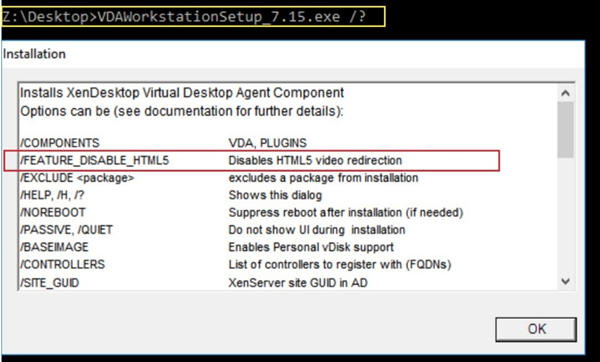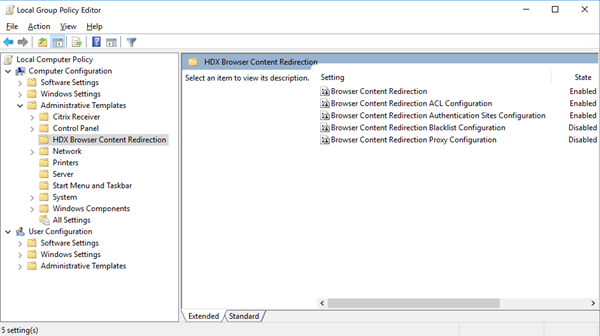Cumulative Update 4 (CU4)
Release date: April 23, 2019
About this release
XenApp and XenDesktop 7.15 LTSR Cumulative Update 4 (CU4) fixes more than 140 issues reported since the release of 7.15 LTSR CU3.
7.15 LTSR (general information)
Issues fixed since XenApp and XenDesktop 7.15 LTSR CU3
Citrix Product Subscription Advantage Eligibility Dates
Downloads
New in this cumulative update
-
When you upgrade Delivery Controllers and a site to 7.15 CU4, preliminary site tests run before the actual upgrade begins. These tests include verification that essential Citrix services are running properly, and that the site database is operating correctly and has been recently backed up. After the tests run, you can view a report. Then, you can fix any issues that were detected and optionally run the tests again. This helps ensure that the upgrade will proceed successfully.
-
This release removes the dependency on Version 2.0 of PowerShell in stand-alone deployments of Citrix Studio and its components.
Note: A version of PowerShell continues to be required on the machines where you install one or more of those components, but the requirement is no longer for Version 2.0. On Delivery Controllers and StoreFront servers, PowerShell 2.0 continues to be required. For more information, see [LD0184]
- If the installation of a VDA or a Delivery Controller™ fails, an MSI analyzer parses the failing MSI log, displaying the exact error code. The analyzer suggests a CTX article, if it’s a known issue. The analyzer also collects anonymized data about the failure error code. This data is included with other data collected by CEIP. If you end enrollment in CEIP, the collected MSI analyzer data is no longer sent to Citrix.
New deployments
How do I deploy CU4 from scratch?
You can set up a brand-new XenApp and XenDesktop® environment based on CU4 - using the CU4 metainstaller. Before you do that, we recommend that you familiarize yourself with the product:
Peruse the XenApp and XenDesktop 7.15 LTSR (initial release) section and pay close attention to the Technical Overview, Install and Configure, and Securitysections before you start planning your deployment. Ensure your setup meets the system requirements for all components.
Existing deployments
What do I update?
CU4 provides updates to baseline components of the 7.15 LTSR. Remember: Citrix recommends that you update all LTSR components of your deployment to CU4. For example: If Provisioning Services is part of your LTSR deployment, update the Provisioning Services components to CU4. If Provisioning Services is not part of your deployment, you do not need to install or update it.
XenApp and XenDesktop 7.15 LTSR CU4 baseline components
| 7.15 LTSR Baseline Component | Version | Notes |
|---|---|---|
| VDA for Desktop OS | 7.15.4000 | |
| VDA for Server OS | 7.15.4000 | |
| Citrix Studio | 7.15.4000 | |
| Citrix Director | 7.15.4000 | |
| Delivery Controller | 7.15.4000 | |
| Federated Authentication Service | 7.15.4000 | |
| Group Policy Management Experience | 3.1.4000 | |
| Linux VDA | 7.15.4000 | See the Linux VDA documentation for supported platforms |
| Profile Management | 7.15.4000 | |
| Provisioning Services | 7.15.15 | |
| Session Recording | 7.15.4000 | Platinum Edition only |
| StoreFront | 3.12.4000 | |
| Universal Print Server | 7.15.4000 |
XenApp and XenDesktop 7.15 LTSR CU4 compatible components
The following components - at the versions given below - are compatible with LTSR environments. They are not eligible for the LTSR benefits (extended lifecycle and fix-only cumulative updates). Citrix might ask you to upgrade to a newer version of these components within your 7.15 LTSR environments.
| 7.15 LTSR CU4 Compatible Components and Platforms | Version |
|---|---|
| App Layering | 1903 |
| *Browser content redirection | 15.15 |
| Citrix SCOM Management Pack for License Server | 1.2 |
| Citrix SCOM Management Pack for Provisioning Services | 1.19 |
| Citrix SCOM Management Pack for StoreFront | 1.13 |
| Citrix SCOM Management Pack for XenApp and XenDesktop | 3.14 |
| HDX RealTime Optimization Pack | 2.4.3000 |
| License Server | 11.15.0.0 Build 26000 |
| Self-Service Password Reset | 1.1.10.0 |
| Workspace Environment Management™ | 1811 |
*Browser content redirection
Redirects the contents of a web browser to a client device, and creates a corresponding browser embedded within Citrix Workspace™ app. This feature offloads network usage, page processing, and graphics rendering to the endpoint. Doing so improves the user experience when browsing demanding webpages, especially webpages that incorporate HTML5 or WebRTC. Only the viewport (the user’s visible area of a webpage) is redirected to the endpoint. Browser content redirection doesn’t redirect the user interface (the address bar, toolbar, and so forth) of the browser on the VDA. For more information see Browser content redirection.
System Requirements:
These requirements are specifically for the BCR.msi with XenApp and XenDesktop 7.15 LTSR CU4. Disregard any browser content redirection system requirements listed in any other versions of XenApp, XenDesktop, and Citrix Virtual Apps and Desktops.
- Version 7.15 LTSR CU4 on both the Delivery Controller and the VDA.
- Citrix Workspace app for Windows 1809 or later.
- BCR.msi - available from the Citrix download page.
- Chrome (with the browser content redirection extension installed from the Chrome WebStore) or Internet Explorer 11 (with the Browser Helper Object (BHO) Citrix HDXJsInjector enabled)
Installation:
-
Install or upgrade the VDA with Version 7.15 LTSR CU4 by using the command line /FEATURE_DISABLE_HTML5 option.

This option removes the HTML5 video redirection feature, which must be done before running the BCR.msi. BCR.msi adds the feature back during installation, and also adds the browser content redirection services. When this step is complete, open the services.msc console and verify that the Citrix HDX HTML5 Video Redirection Service is not listed.
-
Start the browser content redirection installation with the BCR.msi. Depending on your system, the BCR.msi installs its files under:
C:\Program Files\Citrix\ICAService
or
C:\Program Files(86)\Citrix\ICAService
Because the installation is fast, the dialog box might close quickly. If that occurs, rerun services.msc and verify that these services were added.

Policies:
You can control policies using the HKEY_LOCAL_MACHINE registries on the VDA or the HDX™ Browser Content Redirection Citrix administration template for the Group Policy Management Console.
You can download the template from the citrix.com download page under Citrix Virtual Apps and Desktops (XenApp & XenDesktop) > XenApp 7.15 LTSR / XenDesktop 7.15 LTSR > Components. Citrix Studio does not contain these policies.

For more policy information, see Browser content redirection policy settings. For troubleshooting information, see the Knowledge Center article, CTX230052.
Compatible versions of Citrix Workspace app
All currently supported versions of Citrix Workspace app are compatible with the XenApp and Xendesktop 7.15 LTSR. For information about the lifecycle of Citrix Workspace app, see Lifecycle Milestones for Citrix Workspace app & Citrix Receiver.
For your convenience, consider subscribing to the Citrix Workspace app RSS feed to receive a notification when a new version of Citrix Workspace app becomes available.
XenApp and XenDesktop 7.15 LTSR notable exclusions
The following features, components, and platforms are not eligible for 7.15 LTSR lifecycle milestones and benefits. Specifically, cumulative updates and extended lifecycle benefits are excluded. Updates to excluded features and components are available through regular current releases.
| Excluded Features |
|---|
| Framehawk |
| StoreFront™ Citrix Online Integration |
| Excluded Components |
|---|
| Personal vDisk: Excluded for Windows 10 machines; For Windows 7 machines, limited LTSR support until January 14, 2020 (CU requirements apply) |
| AppDisks™ |
| Excluded Windows Platforms * |
|---|
| Windows 2008 32-bit (for Universal Print Server) |
* Citrix reserves the right to update platform support based on third-party vendors’ lifecycle milestones.
Install and upgrade analytics
When you use the full-product installer to deploy or upgrade XenApp or XenDesktop components, anonymous information about the installation process is gathered and stored on the machine where you are installing/upgrading the component. This data is used to help Citrix improve its customers’ installation experiences. For more information, see Install and upgrade analytics.
XenApp 6.5 migration
The XenApp 6.5 migration process helps you more efficiently and quickly transition from a XenApp 6.5 farm to a Site running XenApp 7.15 LTSR CU4. This is helpful in deployments that contain large numbers of applications and Citrix group policies, lowering the risk of inadvertently introducing errors when manually moving applications and Citrix group policies to the new XenApp Site.
After you install the XenApp 7.15 LTSR CU4 core components and create a Site, the migration process follows this sequence:
- Run the XenApp 7.15 CU4 installer on each XenApp 6.5 worker, which automatically upgrades it to a new Virtual Delivery Agent for Server OS for use in the new Site.
- Run PowerShell export cmdlets on a XenApp 6.5 controller, which exports application and Citrix policy settings to XML files.
- Edit the XML files, if desired, to refine what you want to import to the new Site. By tailoring the files, you can import policy and application settings into your XenApp 7.15 LTSR CU4 Site in stages: some now and others later.
- Run PowerShell import cmdlets on the new XenApp 7.15 CU4 Controller, which import settings from the XML files to the new XenApp Site.
Reconfigure the new Site as needed, and then test it.
For more information, see Migrate XenApp 6.x.
In this article
- About this release
- Downloads
- New in this cumulative update
- New deployments
- Existing deployments
- XenApp and XenDesktop 7.15 LTSR CU4 baseline components
- XenApp and XenDesktop 7.15 LTSR CU4 compatible components
- Compatible versions of Citrix Workspace app
- XenApp and XenDesktop 7.15 LTSR notable exclusions
- Install and upgrade analytics
- XenApp 6.5 migration